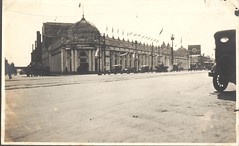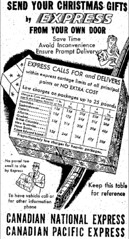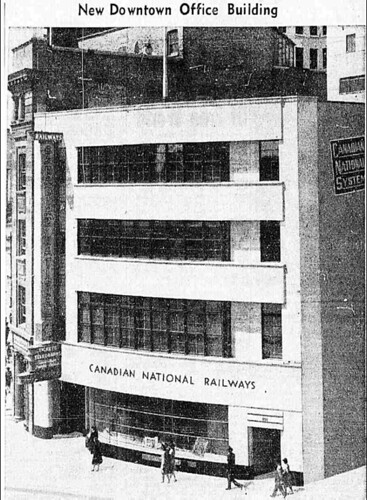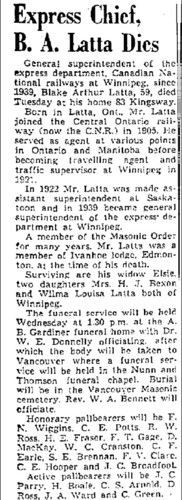This is a three part series about the Latta family who came to Winnipeg in 1939. CN Express, the CN subsidiary that Blake Latta ran, became one of the largest corporations ever to be based out of Winnipeg employing thousands in Canada and around the globe.
One of Blake's first challenges was to tackle an office space shortage for CN Express.
CN Express' executive offices had been located in Union Station since 1921, which is where Blake worked from. Most of their middle management and public offices were situated in the old Industrial Bureau building at Main and Water. There was also a storefront money transfer office at Portage and Main.
In the mid 1930s the Industrial Bureau was demolished to make way for the Federal Building, a Depression relief project. The CN Express space and about 200 employees were split up and sent to a number of locations in and around Main Street.
Christmas 1939
At the same time the demand for office space was increasing. The end of the Depression meant increasing freight volumes. Also, at some point that decade they absorbed Canadian Pacific's Express service (as seen in the above ad the CP Express name appeared in their advertising for a number of years).While on an inspection trip of CN Express' facilities in Vancouver, Blake told a reporter that the volume of freight traffic in 1939 was more than it had been “in many years” (Jan 8, 1940 CP). He certainly didn't realize at that time how quickly those volumes would grow.
Western Canada Loan Block ca. 1900 (source)
The answer to CN's office space woes lay in a very historic lot at the north west corner of Portage and Main. The circa 1883 Western Canada Loan block was owned by CN. Their telegraph division and money wire services were based there.
The land was part of the site where McKenney and Co's store was built. Henry McKenney chose the intersection of two ox cart trails to set up his commercial establishment. Initially a risky choice, being set so far back from the River and the fort, but others eventually joined him and the corner of Portage and Main would become the city's premier intersection.
CN decided that it would be the best location for a new office building and the planning began.
World War II could be described as the best and worst of times for CN.
As a Crown Corporation with extensive networks of rail, road, steamship and air transportation they would be called upon to be front and centre in Canada's war effort.
That 1939 banner year that Blake boasted about above? The amount of freight traffic moved would double by the end of 1943 and CN's passenger volume would quadruple in that same period. (Source).
CN boasted in full page ads that their company was coping and thriving but things must have been tough across all divisions.
The initial problem was the availability of rolling stock and related resources. From fuel to steel, precious resources were being stockpiled for the war effort. Manufacturing and repair facilities, including many of CN's, were switched to wartime production making tanks and munitions. Generations of retired rolling stock were put back into active service.
Soon, though, the crucial role that CN was playing in the war effort was recognized and the manufacture of engines and rail cars were given the go ahead as war-related products and co-financed by the Dominion government.
An additional headache for CN Express in particular was that their typical employees - young, fit men with driving and logistics knowledge - were the prime target for wartime service. In 1943 22% of CN's employees were on active service.
Another division that was working at record level was CN Telegraphs. The service was handling 12 million telegraphs a year across the system including that small, ancient building at Portage and Main which housed the machinery that ran Western Canada's service.
Despite the challenges CN posted years of record profit during the war.
A combination of wartime mentality and the importance of the telegraph service influenced the design of the new CN Building. It was essentially an above ground bunker.
It was four stories like its predecessor but with a larger footprint as it took in much of the lot to the rear of the old building.
A Tribune reporter visiting the site early in construction noted that the building would be practically bomb proof. Nineteen caissons were driven for the foundation ranging from 50 to 90 feet in depth. The construction was of reinforced concrete girders.
It was also built to be fireproof. A Tyndall stone facade on a granite base, metal window frames and even the interior paneling were of terra cotta.
Tucked in amongst the Nanton and McArthur (later Child's) building to the west and the McIntyre Block on the north it was certainly something ... different. At the official opening in June 1942 Mayor Queen “congratulated him (the CN Vice President) on the attractiveness of the outside structure of the building which, he said added greatly to the appearance of Winnipeg.”
In attendance at that opening were a number of CN dignitaries including CN Express General Superintendent Blake Latta whose division would take up the entire third floor.

CN's traffic continued to increase through to the end of the war and even into peacetime. Between 1946 and 1947, for instance, CN Express' freight volumes were up by over 8%.
It was time, though, for CN to take stock and plan for the future. Equipment and facilities across the company were worn out from years of operating at and beyond capacity.
In January 1948 Blake Latta hosted a three day meeting at the Hotel Fort Garry for the western region of CN Express at which 'all phases of handling express traffic' were discussed. (Free Press Jan 30, 1948).
Also early 1948 there was pleasant news on the home front. Eldest daughter Merle Nan, now graduated from Kelvin and working at Eatons, announced a June wedding to Howard Bexton. The event would take place at St. Aidan's church.
It's impossible to know whether or not Blake knew that he was sick at this point. He had developed pancreatic cancer.
It was a disease rarely spoken about in the media, though it was on the rise in men at the time. Radiation technology was still in its infancy but even in trials of x-ray and radium treatment, there was at best a 10% success rate (AP October 28, 1947). A diagnosis of pancreatic cancer meant a quick and certain death.
A family member recalled that Blake was ill 'for some time' before he died at his home on September 13, 1949 at the age of 59. Blake's body was sent to Vancouver for burial at the B.C. Masonic Cemetery.
After Blake's death Elsie and Wilma moved to Vancouver while Nan and her husband stayed in Winnipeg for a time. Soon, the couple moved to Ontario and Elsie and Wilma followed
Elsie Latta died on December 13, 1980 and is buried with Blake in Vancouver. Daughters Nan and Wilma still reside in Ontario just a three hour drive from where Blake was born.
- Click on images for source information, some have multiple sources.
- Family photos are used with permission and supplied by Allyson Latta, Blake Latta’s great-niece, a Toronto-based literary editor and memoir-writing instructor with an interest in genealogy. She teaches life writing online for the University of Toronto.
- I have a great deal of 'leftover' material about the Uptown Theatre, CN Building and St. Aidan's Church. Over time I will compile more thorough histories of these buildings and include the links in the Latta series.




























3 comments:
Very, very interesting post. I had no idea that CN Express was based here at one time.
Very interesting. My name is Larry Latta. Born in Sudbury on. My dad was from Portage la Prarie. We are of Ukranian decent. Is there a match? All I find are Irish Lattas. Please respond.
Thank You,
Larry
I'm not a Latta myself so I am not sure of the lineage of the family.
The woman who asked me to look into the family is Allyson Latta from Ontario. She specializes in memoir writing and has done a history of her family.
She'd likely be able to give you more information about Lattas in Canada http://www.allysonlatta.ca/
I know that someone in her family, I think it was the Latta side, settled in Fortier Manitoba which is near Portage.
I did a quick newspaper scan the first Portage Latta mention I see is that of an Elizabeth Latta of Portage marrying a farmer Daniel McGibbon in 1903. That could be part of your Latta clan ? A William Latta, Elizabeth's father I beleive, died a few years later but his obit makes no mention of what ethnic background he was.
Post a Comment